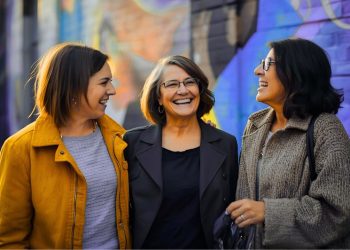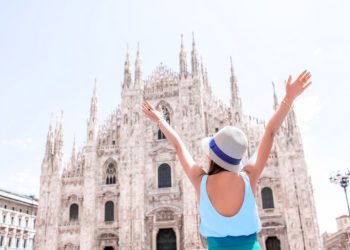Simplicity & Connection Thought Leader – Kay Newton
The Silk Route conjures exotic camel caravans, sandy deserts, the Arabian Knight fables, Aladdin and the gene of the magic lamp.
When the opportunity arose to visit Uzbekistan, to pull me away from the familiar and expand my comfort zones, I did not hesitate.

Now I am back home, reeling from a ten-day sensory overload, and I find myself lost for words – how to describe what this country is truly like. I could talk about beautiful monuments or history, yet unexpected treasures can also be unearthed.

A Landlocked Silk Route:
Arriving at Tashkent airport after a 24-hour journey, we were eager to collect our luggage and get to the hotel. Unfortunately, that was not the case. The flight from Istanbul, Turkey, was overloaded with large parcels, boxes and bags belonging to local passengers. This paraphernalia came off first. Weathered men wearing Western clothes hauled their goods off the conveyor belt, and women in local dress flashing sets of gold teeth carefully guarded the heaping trolleys.

As one of the world’s double-landlocked countries, transport costs disrupt Uzbekistan’s economy and quality of life. Whether a conglomerate or an individual providing cheaper clothes for your family, anything not made in Uzbekistan arrives at a premium. For the same reason, you will only see the Chevrolet badge on the road. The import duties on other automobile brands are astronomical, creating a monopoly for GM Uzbekistan.

Today’s airport baggage contrasts with the country’s historical key role along the ancient Silk Road. A trade route that connected China to Europe. The country’s strategic location made it a crucial hub to exchange goods, such as silk, spices, and precious metals. Everything came through Uzbekistan, a wealthy and prosperous nation without a sea route. It was not just the exchange of goods but also of culture and education.
The Burka Is Banned – Education Vital:
Uzbekistan today is predominantly Muslim, yet the Burka is banned. Written on the Ulugbek Madrasasi, in the city of Bukhara, is the phrase “striving for knowledge is an obligation of every Muslim man and woman” a statement that the Uzbeks are keen to point out.

Historically their development of science and culture, as far back as the 1300s, led to the world’s fundamental understandings of astronomy, mathematics, and algebra to name but a few.
Yet, when the Silk Route declined (due to the development of navigation and the opening of sea routes away from land, and as China lost its silk monopoly), the Uzbecks also lost their standing as thought leaders.
Today the education system struggles with corruption. Teachers are known to ask for grade bribes, adding financial pressure on families. This, in turn, leaves many children, especially in rural areas falling behind.
Plov Is More Than A Meal:
Plov is a staple dish in Uzbek cuisine. You have not visited the country if you haven’t eaten it at least once. It consists of rice cooked with meat (mutton), vegetables (usually yellow carrots) and spices such as cumin and coriander.

In Uzbekistan, plov is more than just a meal. It is a symbol of hospitality and community. Traditionally served at weddings, funerals, and other social gatherings, Plov is a way to bring people together.
The Uzbeks have a proverb: “The visitor is dearer than your father.” As a visitor, you feel safe and welcomed, no matter who you meet on the street. Expect to be asked to pose for photos. Also, to engage in conversations about where you come from and what football team you support. Everyone is interested in you, provided you are open and willing to be interested in them.

Note – to acknowledge the hospitality, why not leave your hosts a gift from your home town? Or better still, take tinned fish (no sea access) or Western medicines. All will be excitedly received.
Music in Uzbek Culture:
Music has long been an essential part of Uzbek culture, with traditional instruments such as the doira (a type of drum) and the dutar (a stringed instrument) playing a central role in local celebrations.

At restaurants, you may notice tables of women seated together. Quite often, they will get up and dance. I was interested to learn that Uzbekistan has a high birth rate and young population. With it comes a need for more employment. To find work and feed their families, men tend to go abroad and find work, especially in Russia. Whilst the men are away, the women dance.
Timur and The Dictator:
Timur the Great (Tamerlane) founded the Timurid Empire in the 14th century. He is admired today in Uzbekistan for his military prowess, cultural achievements, and his patronage of the arts. No one talks openly of the cruel murders of millions under his reign or that he died from catching a common cold.
Today’s Uzbekistan leadership is not openly talked about with visitors either. The country came under Russian control in the 19th Century. It became an independent state in 1991. (Russia was responsible for the ruin of the Aral Sea, the fourth largest inland water in the world). Authoritarian President Islam Karimov ruled from 1989 until he died in 2016.

His successor, Shavkat Mirziyoyev, now in power until 2040, is attempting to break Uzbekistan out of international isolation and economic stagnation. Yet a dictator ruling a country, also in bed with the sleeping dragon (China) and an unstable bear (Russia), reliant on both for financial reform, feels like a future ticking bomb. As an Uzbeck citizen, all you can do is shrug your shoulders, live in the moment and use the Uzbeck phrase. “Qil uchida turibman” (I hang in the balance).
What to Visit:
Beautiful, detailed ceramic tiles are everywhere. Mosaic squares and geometric or floral majolica patterns (originating from the Spanish island of Mallorca, where I reside). You have to like hues of blue as they line the walls of many of the country’s great monuments.

For the tourist, it is hard to know what one is looking at and how to tell the past from the present. So much has been destroyed by invading forces or earthquakes.
In Samarkand alone, you have ‘The Registan’ restored by the Soviets. Truly photogenic and arguably one of Central Asia’s most impressive sights, especially at night. You also have the Gur-e-Amir mausoleum, a prototype of the Taj Mahal.

The Shah-i Zinda necropolis in the northeastern part of Samarkand began with one religious monument more than 1,000 years ago. Over the centuries, it has developed into a series of stately tombs for royalty and nobles. (Also, a shrine to medieval Islamic art).
The newly constructed ‘Silk Road’ complex is also worth a visit. There you can see a replica of the Ulugh Beg Observatory. Whether it’s Taskent, Samarkand, Bukhara or Khiva, you will be overwhelmed with stunning architecture, monuments and history.
A Carpet Ride to Khiva:
As an Uzbek travel virgin, I refused to begin my journey by reaching for a ‘Lonely Planet’ guidebook before setting out.

I wanted to savour the sights from a mental blank canvas. However, I did find a Kindle version of ‘The Carpet Ride to Khiva’ by Christopher Aslan Alexander. It was a fabulous accompaniment for the journey.

As a tourist, there is a massive amount of goods to buy (mostly with made-in-China labels) and a few local artisans with handmade silver, silk, carpets, painted miniatures and Suzanis. When we arrived in Khiva, we sought out the workshop. We briefly spoke with Madrim, one of the main characters. It made the whole trip seem more personal and exclusive.

Extra Travel Tips:
Remember to be a good tourist and go with respect. Uzbekistan has no official dress code, although some Muslim monuments require women’s head scarves and the covering of shoulders and knees.
Learn a few local words ‘Rahmat’ means thank you – it will at least cause a smile. Learn to use a squat loo too! Take your personal medications and medical history.
Carry a water bottle as the water is not safe to drink. We used a Life Straw bottle with a filter to save on plastic waste.
Should I Visit?
YES, you must go. Our 10-day trip was organised through BtravelSpain in the Spanish language. As we left, our tour guide Moustafa remarked that he had a two-hour turnaround before his next group. Certified trained guides are hard to find.
Did you enjoy this article? Become a Kuel Life Member today to support our Community. Sign-up for our Sunday newsletter and get your content delivered straight to your inbox.

About the Author:
Kay is the founder of Midlife Strategies, an award-winning International Speaker, and enthusiastic author. She is an acknowledged expert guiding women to find their mojo, through the Midlife Squeeze.
Kay’s books include:
- ‘The Art of Midlife Stress Busting – Seven Steps to Declutter Your Mind Without Pills or Potions’
- ‘How to Clean Your Home Organically – De-Stress Your Surroundings’
- ‘Tips and Tricks For Stress-Free Downsizing – A Step by Step Guide to Moving On’
- Co-author of the six Kindle books in the ‘Quick Fix For’ series, and a contributing author to ‘Hot Women Rock’ and ‘A Journey of Riches’.
Today, Kay lives a simple life next to a beach in Mallorca, Spain. You can find Kay here: www.KayNewton.com.























